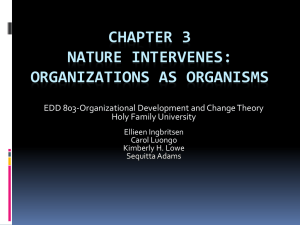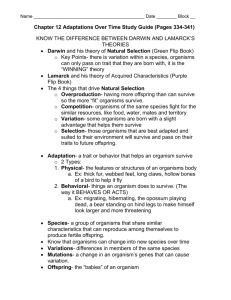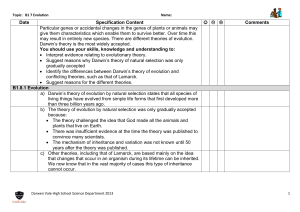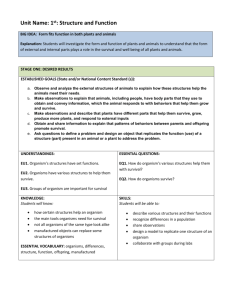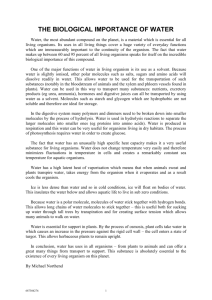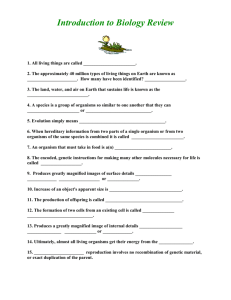Chapter 3: Organizations as Organism
advertisement
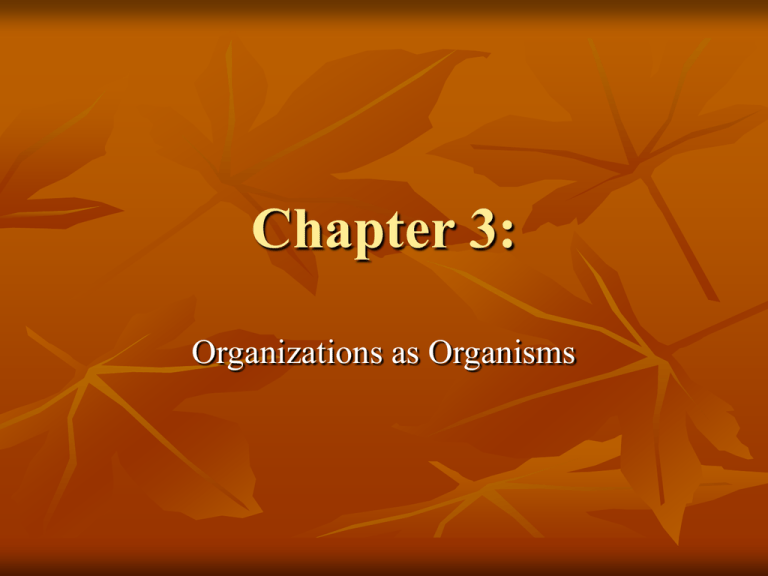
Chapter 3: Organizations as Organisms Organisms Machines are not affected by their environment for the most part. Is this true about organizations? Every aspect of biological and cosmological life is affected by its environment: subatoms, atoms, cells, organisms --- Environment matters. Organizations as Organisms Organisms have different parts that work together to make up an entire system. The system can survive better in some environments more than others. Apply to the workplace History of Organism Metaphor 1) Taylor believed people could be treated like machines. This assumption proved terribly faulty. Even though this assumption seems laughable, the fact that managers borrowed and still implement Taylor’s ideas shows how our common sense can be overridden by overarching metaphors. History of Organism Metaphor 2) Elton Mayo and Hawthorne plants. 3) Maslow “Hierarchy of Needs” 4) Human Resource Management: Workers have Needs – Most workers like meaningful work, responsibility, autonomy and democratic work structures. Socio-Technical Systems show a dependent relationship between technology and human needs. Characteristics of Organism 1) “Open System” – “Organizations, like organisms, are “open” to their environment and must achieve an appropriate relation with that environment if they are to survive.” 38 Machine metaphor assumes nothing external affects the organizations. They are “closed.” Characteristics of Organism 2) Interrelated sub-systems. 3) Alignment between sub-systems and larger systems. Homeostasis Negative entropy Structure, function, differentiation and integration Requisite Variety Equifinality Systems Evolution Theories Derived when Organizations are Viewed as Organisms 1) Contingency Theory (Unit of analysis is individual organization) Good Fits depends on evaluating: Technology Changing Environment Employees (culture) Departments within Organization Management System Theories 2) Varieties of Species:(Unit of analysis is individual organization) Structural design, age, size, technology and conditions of industry affect the “species” of firm to be developed: Typology: Machine Bureaucracy and Divisionlized form Professional Bureaucracy Simple Structure and Adhocracy (Matrix) Theories 3) Population Ecology – Unit of Analysis is Industry NOT Organization. This theory questions the focus on individual organizations. We need to look at how competitive the environment is and the resources organizations have. Environments only let the most competitive and resourceful businesses survive. Most organizations fail to change and thus are in danger of failing when innovation occurs. When environment changes, new organizations are better able to handle change. This theory focuses more on the environment than on individuals within them. Theories 4) Organizational Ecology (Unit of analysis is entire environment) Environments and Organizations are mutually dependent and grow together. Powerful people interact and affect decisions in a variety of areas. Collaboration of organizations is key. Strengths and Weaknesses 1) Acknowledges environment is impt 2) BUT, assumes that the organization is harmonious and that there is one “true” form. If you were to apply the metaphor, which concepts would be critical to include?
